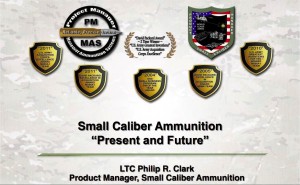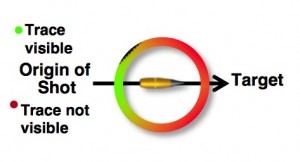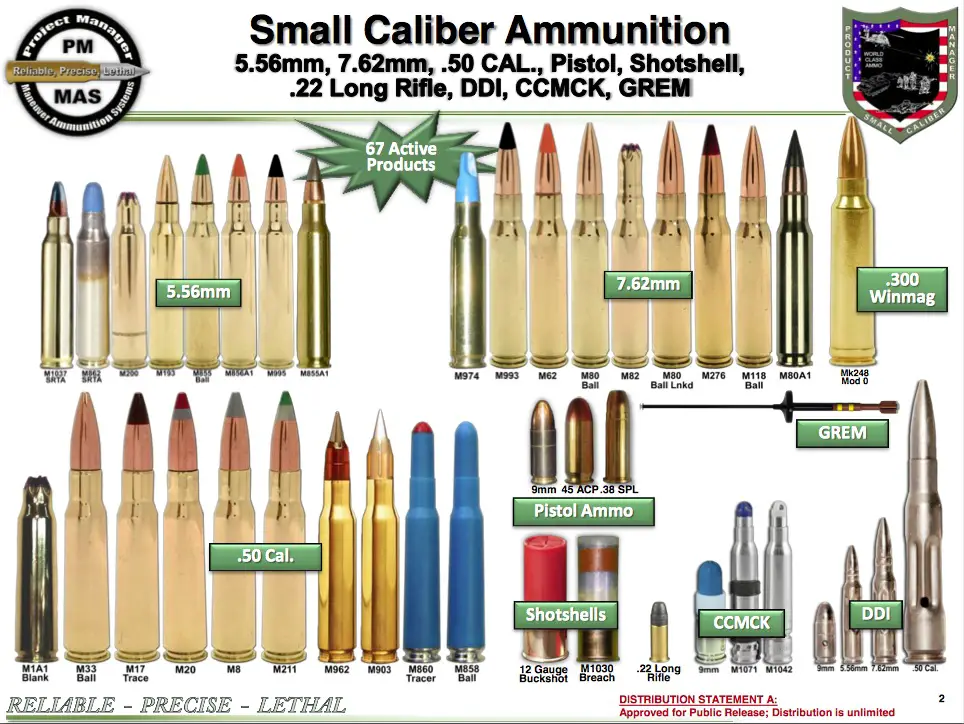 Here’s a recent (2013) presentation (.pdf) from an Armaments and Munitions Conference conducted under the auspices of the National Defense Industrial Association, which used to, in the shadows of time, be the American Defense Preparedness Association, and which was before that the Ordnance Association. NDIA conducts regular conferences on many subjects of interest to WeaponsMan.com readers, and their briefing slides — the military being, for good or for ill, a PowerPoint culture — are generally available to the public at the Defense Technical Information Center. Small Arms and SOF conferences may be of greatest interest, but there are gems in some of the others, like this Armament Conference.
Here’s a recent (2013) presentation (.pdf) from an Armaments and Munitions Conference conducted under the auspices of the National Defense Industrial Association, which used to, in the shadows of time, be the American Defense Preparedness Association, and which was before that the Ordnance Association. NDIA conducts regular conferences on many subjects of interest to WeaponsMan.com readers, and their briefing slides — the military being, for good or for ill, a PowerPoint culture — are generally available to the public at the Defense Technical Information Center. Small Arms and SOF conferences may be of greatest interest, but there are gems in some of the others, like this Armament Conference.
In the presentation, LTC Philip R. Clark, who was then the PM for Small Caliber Ammunition describes what the status of today’s ammo is, and what’s coming next. You can read Clark’s slides as well as we can, so we’ll blithely skip the present ammo inventory, except to slap one slide up here showing the 67 ammo products Clark was managing: eight 5.56mm rounds, nine 7.62mm rounds, the single Mk248 .300 Win Mag round, ten .50 caliber rounds, and various odd jobs: .22 ammo, three pistol calibers, shotgun shells, training/marking, and dummy ammunition. (You get to 67 products from the 40-some illustrated below because of different ways they ship. For instance, M855 can be shipped bulk, in strippers, or linked).
The military acquired and distributed about 1.4 billion rounds of ammunition in Fiscal Year 2013 (Oct 2012-Sep 2013). To put that in perspective, Lake City’s total production was over 2 billion rounds, with the overage going to non-FMS exports and the sporting market.
Future: Fighting at Night
One fact implied in the presentation is that the future will see more fighting at night. Several rounds that offer dim-trace, IR-trace or “one way luminescence” are in development or in production. These rounds are meant to work with night-vision equipment, but also the OWL rounds (fortuitous acronym, that) are meant to upturn the old Murphy’s Law of Combat, the one that reads: “Tracers work both ways.” A world where you don’t see your enemy’s tracers coming is a more dangerous world. A world where the enemy doesn’t see your tracers coming is less dangerous, though — for you, not for him.
 OWL isn’t actually a “tracer” as we’ve come to know them, as it’s not pyrotechnic in nature.
OWL isn’t actually a “tracer” as we’ve come to know them, as it’s not pyrotechnic in nature.
OWL is in R&D now in 7.62, and it’s projected to come in during calendar 2016 in 5.56 mm. A future hope (pipe-dream?) is to provide OWL in ball ammo; it will be nearly 2020 before that’s a reality, if ever. OWL is coming to .50, too.
Right now, the Mk301 dim trace round (not an OWL, but a needs-NV tracer) is in inventory for 5.56, in addition to the standard M856A1, the “green” version of the tracer equivalent to Green Tip. Outside of military night shooting, there’s limited demand for tracers, but they’d look cool hog hunting and we still know guys who put a couple in the bottom of every mag so they’re cued to be ready to change.
No tracer ammo is in production or in planning for the .300 Win Mag or .338 Lapua Mag rounds, which shows you how serious the Army really isn’t about an intermediate or light-heavyweight machine gun.
Safer, Greener Training Ammo
Other major Army fixation is on “green” ammunition. In addition to that, they’re pursuing safer ammunition for short ranges, ammunition that will allow them to reduce range fans (for which the current buzz acronym is SDZ, Surface Danger Zone).
One objective for RRTA, Reduced Range Training Ammo, is to enable collective training (that’s training of units, not individuals) in scenarios on live-fire 360º ranges. It’s quite an engineering challenge to conceive and design a 5.56 round that is ballistically similar to a ball round at close ranges but that has lost all its oomph in 500 yards (460m).
RRTA depends on funding being available and research going well; it is years from being fielded. The Army seems to have scheduled an invention here.
Simunitions for All?
Special Operations Forces have long used Simunitions, marking ammunition for short range/close-quarters force-on-force training. The Army clearly desires to make use of such marking ammunition more widely in training, and doesn’t want to buy proprietary stuff (like Sims) from industry.
Further Out:
Polymer cases offer a serious logistic benefit compared to existing case materials, for US small arms ammunition, mostly brass. There are still some problems (obturation is inferior to brass, and environmental impact greater). Development continues under the name LSCA, Lightweight Small Caliber Ammunition. Barring some unimaginable breakthrough, polymer cases are a better bet for the future than caseless.

Kevin was a former Special Forces weapons man (MOS 18B, before the 18 series, 11B with Skill Qualification Indicator of S). His focus was on weapons: their history, effects and employment. He started WeaponsMan.com in 2011 and operated it until he passed away in 2017. His work is being preserved here at the request of his family.


14 thoughts on “The Future of Army Small Arms Ammunition”
> polymer cases
Those are half a century old now, in the form of shotgun shells. According to my Winchester catalog, the brass base is primarily there for marketing, and to provide a bit of extra purchase for some enthusiastic extractor hooks.
The .38 and .44 Special would look like likely candidates, except for the problem of bullet retention under recoil.
There have been at least two attempts at a plastic .308 case; one briefly made it to the public market before the company vanished. The high pressure .308 is pretty much a worst-case application for plastic, so it was probably intended for military contracts.
Plastic cases may yet come, but the US military likes full-auto weapons that fire from a closed bolt. That was the final deal-breaker for caseless ammo, and brass-cased ammo doesn’t like it much, either. Even if the round doesn’t cook off, the heat can induce odd pressure excursions when the cartridge is fired.
Certain organizations are looking very hard at partially polymer cased .50BMG. (case head area is still brass.)
Weight considerations in certain vehicles is a great concern.
Can anyone give me information on the DDI ammo and also what use the military has for .22? I would assume training, but maybe it is sexier than that.
DDI = Dummy, Drill, and Inert
Daniel answered you on DDI. It’s basically just dummy ammunition for mechanical training. But maintainers use it also; as you can probably imagine, you don’t want to have live ammunition on the bench when you’re working with a balky rifle.
The humble .22 long rifle round is used for training, for target shooting, and the U.S. Air Force actually uses it for rifle qualification, in a 22 conversion on the M-16. As I understand it, not all Air Force personnel have to qualify with the rifle. They all merely fire for familiarization, but peoples whose duties may require them to carry and use rifles have to qualify. People who actually deploy with ground forces, like combat weather personnel and Air Force special operators, train with centerfire ammunition. PJs, CCT’s, and TACP personnel know their guns and are good guys to have around in a fight!
Used to be an Air Force Combat Arms Training and Maintenance guy; think generalized firearms instructor and basic gun-plumbing maintenance in layman’s terms. The Air Force version of the Army’s .22LR M261 kit for the M16 was an exercise in cost savings around the late 70’s through the mid 80’s time frame. Aside from anecdotal use by various reserve component units by the time I joined in ’95 they were all out of use.
As for small-arms training in the AF, it sure leaves a lot to be desired. The primary weapon for officers is the M9, for enlisted it is the M16/M4. With a handful of exceptions, unless there is a specific requirement in line remarks for deployment orders, there isn’t much “cross-training” on weapons, i.e. save for a familiarization on the M16 at the Academy or in ROTC an officer will never touch a rifle and unless you’re aircrew the chances of an M9 qual for an enlisted trooper is not common. And before I’m contradicted, that’s not a hard and fast rule, there are always exceptions.
The AF uses arming categories, A, B and C. Cat A are your SP’s, OSI agents, and anyone that arms daily in the performance of duties; qualification is biannually. Cat B would be your folks that would carry a weapon as a secondary function like couriers, or, would carry a weapon in wartime or contingencies; qualification is essentially annually though I think the book says 15mos. Category C is “all others”. Qualification for Cat C is 24mos (reserve components is 36mos IIRC). All other weapons, M240, M203, M2, Mk19, etc, etc are qualifications that are good for 12mos, but, you only train on them if there is a need, so mostly the SP’s who have the dual role for air base defense. We’d also do the official quals for the SOF guys but they did they’re own training for the most part.
It’s a mentality struggle in the AF. I once had an impressionable Captain tell me that if it was so important for him to be qualified on the M9 then everyone should have to know how to pre-flight his jet. There is no foundation of core or common skills for an airman. The AF is a service of technicians and while they perform those tasks rather well convincing some of them that they are indeed in the military was an uphill fight.
Interesting. For 30+ years the Army has actually developed a Soldier’s Manual of Common Tasks that everyone from the rifleman to the chaplain’s assistant to the staff officers in the Pentagon must be able to do.
The Army manual includes such things as wear the uniform, use individual weapons, perform basic first aid.
I wish we could’ve had that background and I guess there was a half-hearted attempt with the Airman’s Manual. Although that really just turned into something to show the exercise evaluators during the bag drags.
We were introduced to your Army’s SMCT very early on. As an SP and then in the CATM shred out career field they were referenced in well over half the tasks in our training records. When they still shipped our classes up to lovely Ft Dix for the last phase of technical training (AIT essentially) we’d even get our very own copy of the Level 1 SMCT. Still have it somewheres in the bunker.
Wait, they have a 300 win mag Pistol?
Why wasn’t I told about this?
Page 5 of the PDF.
Heh. Couple of tracers in the mag bottom. I like that.
Btw http://www.polycase.com offers some calibers in polymer cases as well as the ARX copper/polymer “wonder bullet”. Got a youtube channel too. Dunno how much of it is hype though.
Oops. Screwed that up. It’s http://polycaseammo.com/
I didn’t see MK262on the slide for 5.56 loadins, is that still used?
S/F
Nik
I do not think Big Green ever paid for Mk262 or its development. I believe it was always bought by USSOCOM under MFP-11 (Major Force Program-11) money although some may have been acquired with OCO (Overseas Contingency Operations) dollars by conventional forces. As a rule of thumb, if a requirement is common to the whole service it is funded under MFP-2, General Purpose Forces, authority, and if it is SOF peculiar it falls under MFP-11. That’s also why Mk 262 has not been type-standardized as M999 or something (the latest AP round in 5.56 is M995 so that’s where we’re up to numbers wise).
Only SOF have the 5.56 precision rifles (Mk 12 SPR) for which the round is ostensibly manufactured. As everybody has found out, it works pretty well in an M4 or M16 too. (It’s wasted in an M249 unless you have the select-fire grip IMHO). The Marines’ M27 IAR would be the heat with the Mk 262, but officially it’s supposed to be shot with M855! The Mk 262 does not meet the NATO 800m penetration test, I think.
I haven’t tried them under NV yet, but a year or two back I loaded a bunch of 45 and 9mm ball with (brand name escapes me) small non-pyro stickers that attach to the back that activate under the pressure of firing similar to a chem light. In daylight they weren’t really visible but provided a dim green trace in low light. Since they attached to the rear of the bullet they may be a “cheap” civilian OWL-type alternative. I don’t know the utility of a pistol-caliber tracer but they were fun to play with out to 300 yards in carbines and subguns and didn’t violate my range’s fire precautions which was the biggest benefit.